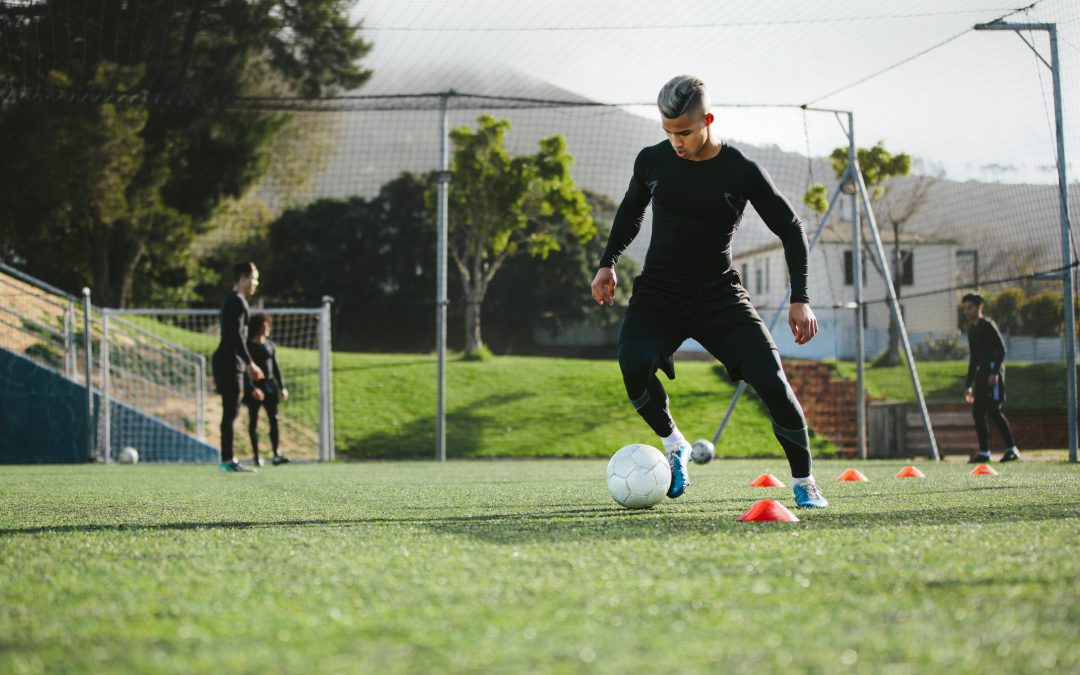Whether it’s semi-pro standard or weekend five aside, everyone’s keen to improve their performance on the pitch. Penalty practice and drills are, of course, important, but there’s a lot of work you can be doing in the gym to support your development as a well-rounded player. Make the first eleven or just impress your mates. Hussle’s got you covered.
Build stamina & endurance
Often used together, stamina and endurance are actually slightly different. Stamina is your ability to perform at maximum intensity for bursts of time. Endurance is your ability to continue going for a prolonged period but not always going at maximum effort. Think of being able to sprint after the ball from your team’s box and keep going all the way to the oppositions – that’s stamina. But being able to last the entirety of a 90-minute match without fatiguing – that’s endurance.
In football, you obviously need a bit of both. Interval style training is a great way to develop your overall aerobic fitness. A continuous workout or run that involves periods of more intense exercise will help you build your endurance and stamina. For example, on your usual 5km jog, start including 0.5km bursts of a much faster pace before bringing it back down again. No Messi-ng around.
Practice plyometrics
Plyometric training involves explosive movements that lengthen and then shorten the muscles in quick succession. Think maximum force in short bursts of time.
Plyometrics help increase your speed strength, which is an essential skill in football. In a fast-paced game where things change quickly, you need speed strength to keep up. Think kick speed and power. Think rapid changes of direction. It takes a particular type of exercise to develop your speed strength. Plyometric exercises like tuck jumps, Squat jump, box jumps, reverse lunge with knee ups will help you work on it.
Increase the intensity in circuit training
High-intensity interval training (or HIIT) increases your aerobic and anaerobic fitness. Both of these abilities help during a match as they let you work for the full 90 minutes, including shorter periods of intense sprints and competitive play.
HIIT training in a circuit-style workout with weights is a great way to increase aerobic and anaerobic fitness, as well as muscular endurance and muscular strength. Essentially, you’re conditioning the cardiovascular system and the muscular system simultaneously, giving you all the different components of full-body fitness that you need to perform on the pitch.
There are many types of HIIT and circuit workouts you can do either in a class or on your own.
1. Start by setting a time limit. 30 minutes is plenty.
2. Pick a free weight. A set of dumbbells can provide lots of exercise variety.
3. Choose two high tempo or plyometric exercises like burpees and squat jumps.
4. Choose three weighted compound exercises that give you an excellent full-body burn. Go for double phased movement ones for increased efficiency. Thrusters, Snatches, and push up to renegade row would work perfectly.
5. Perform the 5 exercises one after the other. Work for 45 seconds and rest for 15 seconds.
6. Repeat the round of exercises 4-5 times, taking a 60-second break in between.
Focus on the lower body
Your lower body is much needed when it comes to football. That’s probably the understatement of the article.
Make time for 1-2 lower body days in your gym routine, so you can build adequate strength and endurance in your glutes, quads, hamstrings and calves. Those muscles provide the majority of the support you need on the pitch, so you’ll want to get them into excellent condition.
Muscular strength is increased by the load or weight of your lifts. Muscular endurance is increased by the number of reps you’re doing. Work on both. It’s essential to apply progressive overload if you want to see the benefit of your workout.
Pay attention to coordination
The need for coordination in football is an obvious one. So, we won’t spend time telling you why it’s worth improving. To get technical, your coordination skills and also your balance rely on proprioception. This means the sense of your body in space. The way it moves, where parts of it are, and your distance from things. It’s an innate awareness that develops as we get older.
Both strength training and plyometrics can be used to increase coordination. But there are some extra hacks you can try to improve further. Try doing exercises with your eyes closed to heighten and focus on your proprioceptive senses. Try Yoga. It’s a great way of being present and aware of your body and develop strength and skills you didn’t know you were missing.
Ready to put in the extra effort and improve your performance on the pitch? Use Hussle to access a gym whenever you want.



